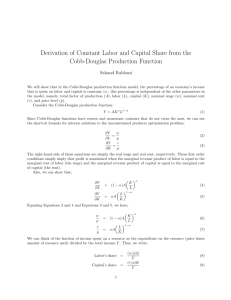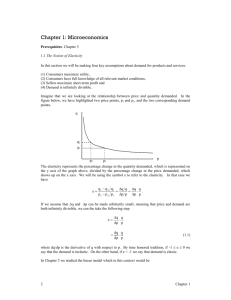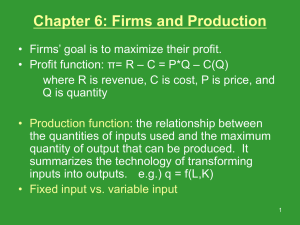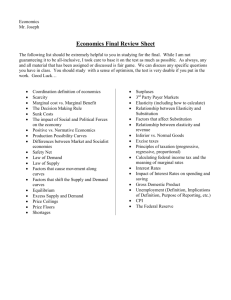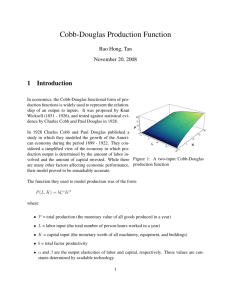document
advertisement
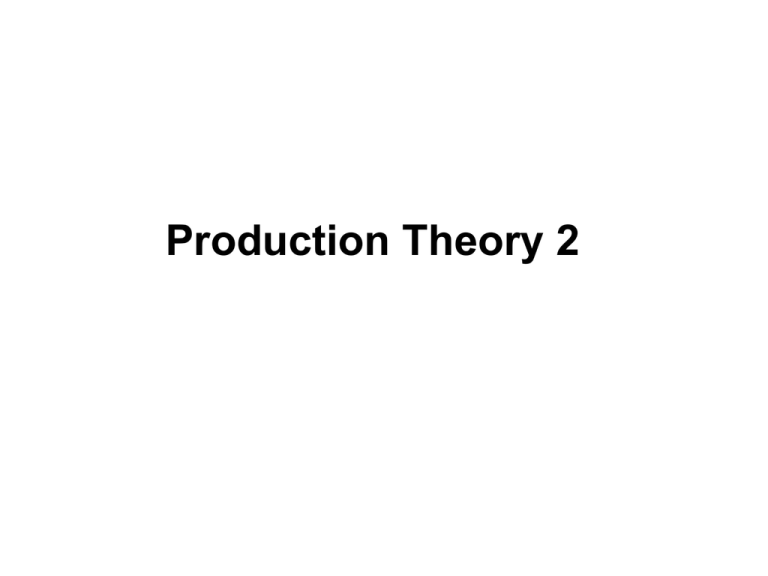
Production Theory 2
Returns-to-Scale
Marginal
product describe the
change in output level as a single
input level changes. (Short-run)
Returns-to-scale describes how the
output level changes as all input
levels change, e.g. all input levels
doubled. (Long-run)
Returns-to-Scale
If, for any input bundle (x1,…,xn),
f (tx1, tx2 ,, txn ) t. f ( x1, x2 ,, xn )
then the technology described by the
production function f exhibits constant
returns-to-scale, e.g. doubling all input
levels doubles the output level (t=2).
Note: Books often (confusingly) replace
t with k.
Returns-to-Scale
One input
Output Level
y = f(x)
2y’
Constant
returns-to-scale
y’
x’
2x’
Input Level
x
Returns-to-Scale
If, for any input bundle (x1,…,xn),
f (tx1 , tx2 ,, txn ) tf ( x1 , x2 ,, xn )
then the technology exhibits decreasing
returns-to-scale, e.g. doubling all input
levels less than doubles the output level
(t=2).
Returns-to-Scale
One input
Output Level
2f(x’)
y = f(x)
f(2x’)
Decreasing
returns-to-scale
f(x’)
x’
2x’
Input Level
x
Returns-to-Scale
If, for any input bundle (x1,…,xn),
f (tx1, tx2 ,, txn ) tf ( x1, x2 ,, xn )
then the technology exhibits increasing
returns-to-scale, e.g. doubling all input
levels more than doubles the output level
(t=2).
Returns-to-Scale
One input
Output Level
Increasing
returns-to-scale
y = f(x)
f(2x’)
2f(x’)
f(x’)
x’
2x’
Input Level
x
Returns-to-Scale: Example
The Cobb-Douglas production function is
2 x an .
y x1a1 xa
n
2
(kx1 )a1 (kx 2 )a 2 (kxn )an ka1 an y.
The Cobb-Douglas technology’s returnsto-scale is
constant
if a1+ … + an = 1
increasing if a1+ … + an > 1
decreasing if a1+ … + an < 1.
Short-Run: Marginal Product
A
marginal product is the rate-ofchange of output as one input level
increases, holding all other input
levels fixed.
Marginal product diminishes
because the other input levels are
fixed, so the increasing input’s units
each have less and less of other
inputs with which to work.
Long-Run: Returns-to-Scale
When
all input levels are increased
proportionately, there need be no
such “crowding out” as each input
will always have the same amount of
other inputs with which to work.
Input productivities need not fall and
so returns-to-scale can be constant
or even increasing.
Homogenous Production Function
A production function is homogeneous of
degree if
F(tK, tL) = t F(K,L) for all t.
If = 1 CRS
If > 1 IRS
If < 1 DRS
Note: Not all production functions are
homogeneous. (Y = 1 + L + K)
Perfect Substitutes
Constant Returns to Scale: Show
K
Y=aK + bL
MRTS= (-) b/a
L
Perfect Complements
Constant Returns to Scale: Show
Y = Min {L, K}
K
Y=Y1
Y=Yo
L
Cobb-Douglas
Homogeneous of degree ( + )
Y=AKL
K
Y=Y1
Y=Yo
L
Properties of Cobb-Douglas Production Function
Y=AKL
The Cobb-Douglas is homogeneous
of degree = (+ ).
Properties of Cobb-Douglas Production Function
Proof: Given Y=KL now introduce t
Y=(tK)(tL)
Y= t K t L
Y=t + K L
Y= t + Y
Y=tY as =+
If =1
(+=1) then
CRS
If >1
(+>1) then
IRS
If <1
(+<1) then
DRS
Properties of Cobb-Douglas Production Function
Output Elasticity Y=AKL
Y K
.
K Y
Y L
.
L Y
For Capital
(show)
For Labour
(show)
Properties of Cobb-Douglas Production Function
Y=AKL
Marginal Product of Capital (show)
. APk
Marginal Product of Labour (show)
. APL
Properties of Cobb-Douglas Production Function
Y=AKL
Marginal Rate of Technical
Substitution (MRTS = TRS)
K
L
Show
Properties of Cobb-Douglas Production Function
Y=AKL
Euler’s theorem:
MPK K MPL L ( )Y
Where is the degree of homogeneity
(show)
Elasticity of Substitution
The
Elasticity of Substitution is the
ratio of the proportionate change in
factor proportions to the
proportionate change in the slope of
the isoquant.
Intuition: If a small change in the
slope of the isoquant leads to a large
change in the K/L ratio then capital
and labour are highly substitutable.
Elasticity of Substitution
= % Change in K/L
% Change in Slope of Isoquant
= % Change in K/L
% Change in MRTS
Elasticity of Substitution
A small change
in the MRTS
K
Large change in
K/L
High
L
K and L are
highly
substitutable for
each other
Elasticity of Substitution
A large change
in the MRTS
K
Small change in
K/L
Low
L
K and L are not
highly
substitutable for
each other
Elasticity of Substitution
K L
K / L
K L
K L
Properties of Cobb-Douglas Production Function
Y=AKL
The elasticity of substitution = 1
K L
K / L
K L
K L
Show
Properties of Cobb-Douglas Production Function
In
equilibrium,MRTS = w/r and so the
formula for reduces to,
% in K
% in w
L
r
Useful for Revision Purposes:
Not Obvious Now
Properties of Cobb-Douglas Production Function
the Cobb-Douglas, =1 means
that a 10% change in the factor price
ratio leads to a 10% change in the
opposite direction in the factor input
ratio.
For
Useful For Revision Purposes:
Not Obvious Now
Well-Behaved Technologies
A
well-behaved technology is
– monotonic, and
– convex.
Well-Behaved Technologies Monotonicity
Monotonicity:
More of any input
generates more output.
y
y
monotonic
not
monotonic
x
x
Well-Behaved Technologies Convexity
If the input bundles x’
and x” both provide y units of output
then the mixture tx’ + (1-t)x”
provides at least y units of output,
for any 0 < t < 1.
Convexity:
Well-Behaved Technologies Convexity
x2
x'2
x"2
y
x'1
x"1
x1
Well-Behaved Technologies Convexity
x2
x'2
tx'1 (1 t )x"1 , tx'2 (1 t )x"2
x"2
y
x'1
x"1
x1
Well-Behaved Technologies Convexity
x2
Convexity implies that the
MRTS/TRS decreases as x1
increases.
x'2
x"2
x'1
x"1
x1
